Search the Special Collections and Archives Portal
Search Results
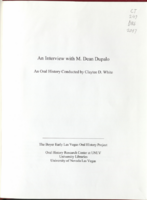
Transcript of interview with Martin Dean Dupalo by Claytee D. White, October 24, 2005
Date
2005-10-24
Archival Collection
Description
Martin Dean Dupalo was born February 20, 1967. His parents were Eva Auge, a German citizen, and Milton Dupalo. Martin shares many stories and anecdotes concerning his family background, his father's 21 year military career, his mother's tribulations in WWII Berlin, and the many sites the family visited all over the world. Martin gives a wealth of details regarding Las Vegas and UNLV in the seventies and eighties. He lists the schools he attended in Clark County and recalls some of the friends and professors his father knew while attending UNLV. Martin graduated from Eldorado High in 1985, attended UNLV, and was selected for a Truman Congressional Scholarship at Carnegie Mellon in Pittsburgh, Pennsylvania. He describes the house and surrounding area in which he and his father and brother, Michael Dean, lived. He also includes comments and anecdotes regarding entertainment in the Vegas Valley. After a stint as a fire fighter, four years in the Air Force and Air Force Reserve, and a brief marriage, Martin began teaching at UNLV in 2003. He discusses race relations as he has experienced them in his family, the military, Las Vegas, and at UNLV. His closing comments are in regard to war, world population, and the possibility of peace.
Text
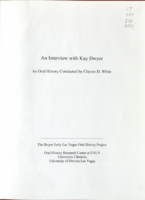
Transcript of interview with Kay C. Dwyer by Claytee D. White, August 16, 2000
Date
2000-08-16
Archival Collection
Description
Kay Dwyer was born August 30, 1934 to James and Eileen Crawford. Her father attained a job as an accountant with Basic Magnesium Incorporated in 1942. This meant that the family moved to Henderson, Nevada, which was a brand new community back in the early 1940's. The BMI plant, which manufactured magnesium for bombs and other war materials, is discussed throughout the interview. The interview begins with Kay reading a composition that she wrote entitled, "Our Summer of 1942 and More." In the reading she talks about the early years of her life when she first moved to southern Nevada. Kay gives remarkable details about the towns of Basic and Henderson (Basic became the town of Henderson) were like during this historic period. In 1952, she graduated from Basic High School and then moved to Los Angeles to attend Pepperdine University for two years. She moved back to the Las Vegas area and started a family with Stanly Hardy with whom she had three children. Sadly, at age 31 Stanly passed away from pancreatic cancer. After a break, Kay decided to go back to school and graduated from Nevada Southern University (now UNLV). Upon graduation, she immediately began teaching at Clark High School. In 1968, Kay married George Dwyer after being a widow for five years. Later, she taught at Las Vegas High School where she would go on to spend the next 25 years until 1995. This interview is an excellent resource for quality information pertaining to the early years of Southern Nevada. Kay Dwyer's extraordinary experiences provide us with a special look at the history of Las Vegas.
Text

Transcript of interview with Marion B. Earl by Robert A. Pearce, March 13, 1976
Date
1976-03-13
Description
On March 13, 1976, Robert Pearce interviewed attorney Marion B. Earl (Born September 13, 1897 in Bunkerville, Nevada) at his home in Las Vegas, Nevada. Marion relocated to Las Vegas in 1923. During the interview Marion discusses serving as a member of the board of directors for the Chamber of Commerce, and then being elected president of the chamber in 1941. He also discusses being elected justice of the peace in 1934, and serving for two terms. He offers additional insight on the growth of Las Vegas and the history of Southern Nevada.
Text

Transcript of interview with Clarles Alvin (Todd) Early conducted by Brenda Sue Cody, March 25, 1981
Date
1981-03-25
Archival Collection
Description
On March 25, 1981, Brenda Sue Cody interviewed local business owner, Charles Alvin (Todd) Early, Jr. (born in Yerington, Nevada) at his Central Credit office in Las Vegas, Nevada. The interview covers the history of Nevada. During the interview, Charles discusses mining, the building of Boulder (Hoover) Dam, and travelling by train as the central mode of transportation, in the early days. He also discusses a quick and easy divorce process and gambling as the main tourist attractions in Nevada.
Text

Transcript of interview with Tom Ehlen by Lisa Gioia-Acres, January 10, 2008
Date
2008-01-10
Archival Collection
Description
Tom Ehlen is a professional trumpet player. He played with the Glenn Miller Orchestra, Frank Sinatra, Burt Bacharach, and many others. He made his home in Las Vegas and played in the bands of various casinos. Tom now plays for the Las Vegas Classic Jazz Band at the Gold Coast and is in shows such as The Producers.
Text
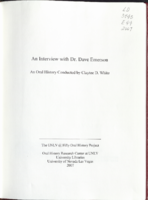
Transcript of interview with Dr. David Emerson by Claytee D. White, December 21, 2005
Date
2005-12-21
Archival Collection
Description
Dr. Dave Emerson was born in Littleton, Massachusetts. His father, a mining engineer, moved the family to Mexico twice, once when Dave was one year old and again when he was seven. In 1938, his father retired to work on his apple orchard in Littleton. Dave helped with pruning, spraying and dusting for insects, and hauling apples to the cider mill. Dr. Emerson graduated from high school in Littleton in 1945 and joined the army. Because he was only 17, the army sent him to Norwich University in Vermont until he turned 18. He then went on active duty until December, 1947. After he mustered out, Dartmouth College accepted his credits and he completed courses through his junior year. He was then called back to active duty in the Korean conflict, and was assigned to the Army Chemical Center in Maryland. After his army stint, Dr. Emerson worked a summer for Dow Chemical as a research engineer, and then returned to Michigan to pursue a Master's degree. He met and married his wife during this time. After completing his doctorate, Dave went to work for Shell Oil Company. Dave spent six years with Shell and decided to turn to teaching. He took a job at a branch of the University of Michigan. He worked there 17 years, doing research, teaching, and even spending a little time as chairman of the Division of Art, Sciences, and Letters. He was then notified of an opening at UNLV for dean of the College of Science, Math, and Engineering. In 1981, Dr. Emerson and his wife moved to Las Vegas, and he began teaching chemistry classes. He was instrumental in building up the engineering department through distance education for students who needed credits in math, computer skills, or electrical engineering. He also helped put together and sell the idea of a strong engineering school at UNLV, and then worked to gain accreditation for civil, mechanical, electrical and other areas of engineering. After retiring in 1998, Dr. Emerson worked on the self-study for the year 2000 accreditation. He still does research at UNLV on a volunteer basis. He and his wife continue to enjoy their home here in Vegas as well as their travels around the country.
Text
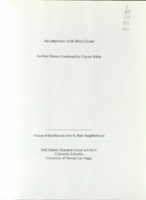
Transcript of interview with Steve Evans by Claytee D. White, June 15, 2010
Date
2010-06-15
Archival Collection
Description
Steve Evans is a native of Henderson, Nevada; living there when it was little more than an industrial town. In this interview, Steve tells of his humble life in Henderson's Carver Park community to becoming the owner of a home formerly owned by a teenage mentor, Flora Dungan, who founded Focus, a youth counseling program where he worked. Steve's penchant for architecture threads through this narrative. Among the stories he shares is of his efforts to recover information about his John S. Park home, which was built in 1964, designed by Kennard Design Group of California and considered the best example of mid-century modern architecture in Las Vegas. In addition, Steve is an informed observer of a community in transition. He tells about the thriving commerce of Fremont Street shifting to Maryland Parkway, the beginning of the Arts District, the impact of events on the John S. Park Neighborhood sense of community, events such as the Stratosphere wanting to build a roller coaster as well as the movement to give John S. Park a historical designation. Steve left Las Vegas for a few years to purse his career in social justice and activism. He returned home and has been a involved in community service, a City Planning Commissioner, Chair of the Downtown Design Review among other committees.
Text

Transcript of interview with Robert M. Fisher by DeeAnn Coombs, March 20, 1978
Date
1978-03-20
Archival Collection
Description
On March 20, 1978, DeeAnn Coombs interviewed Robert M. Fisher (born 1945 in Las Vegas, NV) about his experience growing up in and living in Southern Nevada. Fisher first discusses his background and upbringing, from being born at Nellis Air Force Base to attending several schools in Las Vegas and joining the U.S. Navy. Fisher also talks about the development of Las Vegas, particularly the Strip properties, and the various recreational activities in which he would participate, such as water skiing, drag racing, and skydiving. Fisher also talks about his work at the Nevada Test Site, including his work as a draftsman for the underground atomic testing.
Text

Transcript of interview with Charles Nur Fernald by Claytee D. White, May 31, 2014
Date
2014-05-31
Archival Collection
Description
Dancer Charles Nur Fernald first came to Las Vegas in 1963 to perform for five weeks in the Kay Starr Show at the Sahara Hotel and again in 1964 working with Donn Arden for three months at the Desert Inn Hotel. Born in Detroit, Michigan, in 1939, Charles moved several times to various places in Arizona and southern California with his parents, Charles Knox Fernald and Marguerite Marie Higgins Fernald, and half-siblings before settling in Hollywood, California, where he remained (except for his short stints in Las Vegas) from 1961 to 1967. In January 1968 Charles came to Las Vegas to perform with Sid Caesar and Imogene Coca at the Flamingo Hotel. After the show closed Charles auditioned for Donn Arden to dance in the Lido de Paris show at the Stardust Hotel, where he remained for sixteen years, 1968 through 1984. He remains the only male dancer who performed with Lido through five different, consecutive productions. In 1969 Charles met his partner, Aquiles Garcia, who was a dancer at the Dunes Hotel. The couple remain in Las Vegas and have been together forty-five years. Charles’s father was very poor and left school after the third grade to go to work and help support his family. He was born in 1889 in Philadelphia, Pennsylvania, the fifth of eleven children. As an eight-year-old he became a “groundhog,” a digger of New York’s underwater tunnels, who helped build the Holland Tunnel. At fifteen he made more money than his father selling newspapers, fresh fruit, and clothing door to door or from the street corner. According to Charles, his father “drank too much, ate too much, smoked too much, and loved too much.” As an only child, Charles’s mother had a very different upbringing from his father, although her family too was very poor. She was born in Detroit in 1902 to a railroad switchman father and mother who not only scrubbed the floors of wealthy Detroiters but also cooked meals for twenty-one boarders at a rooming house. Marguerite’s parents worked hard so they could send their only child to Catholic school and the Detroit Conservatory of Music.
Text
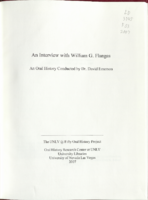
Transcript of interview with William G. Flangas by Dr. David Emerson, September 27, 2006
Date
2006-09-27
Archival Collection
Description
William Flangas was born in Ely, Nevada, in 1927. He attended grade school through high school in White Pine County. In his junior year, he left school to join the Navy. After the war, he enrolled at UNR on the G.I. Bill, and graduated with a degree in metallurgical engineering. In 1951, Bill worked for Kennecott in a 'deep root' project, spent a summer in Chile working in a smelter, and then went back to work for Kennecott in underground operations. On the basis of this experience, he wrote a thesis and earned an EM degree (Engineer of Mines). Bill was approached in 1958 by Mr. Reynolds of the Reynolds Electric/Engineering Company with a request that he come help them out at the Nevada Test Site. He refused at first, but after a second call and a visit to the tunnel site, he accepted the job, pulled together a first-rate group of experienced miners, and stayed on to enjoy a 40 year career concurrent with the job at the test site, Bill was appointed to the State Planning Board, later renamed the State Public Works Board. The function of the board was to list public buildings in order of priority. In 1984, the College of Engineering at UNLV made the priority list. Bill helped set up three point contact among the university personnel, the architectural firm, and the Public Works Board. This was to ensure that the building met the needs of the engineers but did not go over budget.
Text
Pagination
Refine my results
Content Type
Creator or Contributor
Subject
Archival Collection
Digital Project
Resource Type
Year
Material Type
Place
Language
Records Classification
